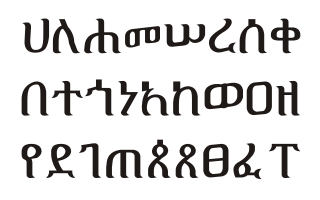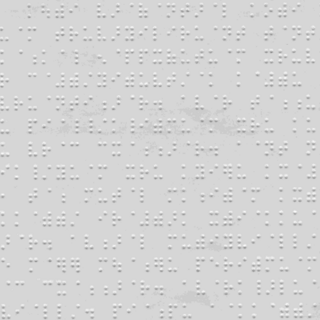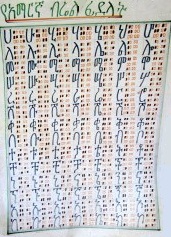
Japanese Braille is the braille script of the Japanese language. It is based on the original braille script, though the connection is tenuous. In Japanese it is known as tenji (点字), literally "dot characters". It transcribes Japanese more or less as it would be written in the hiragana or katakana syllabaries, without any provision for writing kanji.

Geʽez is a script used as an abugida (alphasyllabary) for several Afro-Asiatic and Nilo-Saharan languages of Ethiopia and Eritrea in the Horn of Africa. It originated as an abjad and was first used to write the Geʽez language, now the liturgical language of the Ethiopian Orthodox Tewahedo Church, the Eritrean Orthodox Tewahedo Church, the Eritrean Catholic Church, the Ethiopian Catholic Church, and Haymanot Judaism of the Beta Israel Jewish community in Ethiopia. In the languages Amharic and Tigrinya, the script is often called fidäl (ፊደል), meaning “script” or “letter”. Under the Unicode Standard and ISO 15924, it is defined as Ethiopic text.
Thai Braille (อักษรเบรลล์) and Lao Braille (ອັກສອນເບຣລລ໌) are the braille alphabets of the Thai language and Lao language. Thai Braille was adapted by Genevieve Caulfield, who knew both English and Japanese Braille. Unlike the print Thai alphabet, which is an abugida, Thai and Lao Braille have full letters rather than diacritics for vowels. However, traces of the abugida remain: Only the consonants are based on the international English and French standard, while the vowels are reassigned and the five vowels transcribed a e i o u are taken from Japanese Braille.
Tibetan Braille is the braille alphabet for writing the Tibetan language. It was invented in 1992 by German socialworker Sabriye Tenberken. It is based on German braille, with some extensions from international usage. As in print, the vowel a is not written.

Russian Braille is the braille alphabet of the Russian language. With suitable extensions, it is used for languages of neighboring countries that are written in Cyrillic in print, such as Ukrainian and Mongolian. It is based on the Latin transliteration of Cyrillic, with additional letters assigned idiosyncratically. In Russian, it is known as Шрифт Брайля.

Bharati braille, or Bharatiya Braille, is a largely unified braille script for writing the languages of India. When India gained independence, eleven braille scripts were in use, in different parts of the country and for different languages. By 1951, a single national standard had been settled on, Bharati braille, which has since been adopted by Sri Lanka, Nepal, and Bangladesh. There are slight differences in the orthographies for Nepali in India and Nepal, and for Tamil in India and Sri Lanka. There are significant differences in Bengali Braille between India and Bangladesh, with several letters differing. Pakistan has not adopted Bharati braille, so the Urdu Braille of Pakistan is an entirely different alphabet than the Urdu Braille of India, with their commonalities largely due to their common inheritance from English or International Braille. Sinhala Braille largely conforms to other Bharati, but differs significantly toward the end of the alphabet, and is covered in its own article.

The Esperanto language has a dedicated braille alphabet. One Esperanto braille magazine, Esperanta Ligilo, has been published since 1904, and another, Aŭroro, since 1920.
The goal of braille uniformity is to unify the braille alphabets of the world as much as possible, so that literacy in one braille alphabet readily transfers to another. Unification was first achieved by a convention of the International Congress on Work for the Blind in 1878, where it was decided to replace the mutually incompatible national conventions of the time with the French values of the basic Latin alphabet, both for languages that use Latin-based alphabets and, through their Latin equivalents, for languages that use other scripts. However, the unification did not address letters beyond these 26, leaving French and German Braille partially incompatible and as braille spread to new languages with new needs, national conventions again became disparate. A second round of unification was undertaken under the auspices of UNESCO in 1951, setting the foundation for international braille usage today.
Luxembourgish Braille is the braille alphabet of the Luxembourgish language. It is very close to French Braille, but uses eight-dot cells, with the extra pair of dots at the bottom of each cell to indicate capitalization and accent marks. It is the only eight-dot alphabet listed in UNESCO (2013). Children start off with the older six-dot script, then switch to eight-dot cells when they start primary school and learn the numbers.
Portuguese Braille is the braille alphabet of the Portuguese language, both in Portugal and in Brazil. It is very close to French Braille, with slight modification of the accented letters and some differences in punctuation.
According to UNESCO (2013), there are different braille alphabets for Urdu in India and in Pakistan. The Indian alphabet is based on national Bharati Braille, while the Pakistani alphabet is based on Persian Braille.
Punjabi Braille is the braille alphabet used in India for Punjabi. It is one of the Bharati braille alphabets, and largely conforms to the letter values of the other Bharati alphabets.
Similar braille conventions are used for three languages of India and Nepal that in print are written in Devanagari script: Hindi, Marathi, and Nepali. These are part of a family of related braille alphabets known as Bharati Braille. There are apparently some differences between the Nepali braille alphabet of India and that of Nepal.
Hawaiian Braille is the braille alphabet of the Hawaiian language. It is a subset of the basic braille alphabet,
Dzongkha Braille or Bhutanese Braille, is the braille alphabet for writing Dzongkha, the national language of Bhutan. It is based on English braille, with some extensions from international usage. As in print, the vowel a is not written.

Burmese Braille is the braille alphabet of languages of Burma written in the Burmese script, including Burmese and Karen. Letters that may not seem at first glance to correspond to international norms are more recognizable when traditional romanization is considered. For example, သ s is rendered ⠹th, which is how it was romanized when Burmese Braille was developed ; similarly စ c and ဇ j as ⠎s and ⠵z.
Several braille alphabets are used in Ghana. For English, Unified English Braille has been adopted. Four other languages have been written in braille: Akan (Twi), Ga, Ewe, and Dagaare. All three alphabets are based on the basic braille letter values of basic Latin alphabet:
Khmer Braille is the braille alphabet of the Khmer language of Cambodia.
Catalan Braille is the braille alphabet of the Catalan language. It is very close to French Braille: it uses the 26 letters of the basic braille alphabet, plus several additional letters for ç and what are, in print, vowel letters with diacritics; these differ from their French values only in the need to accommodate the Catalan acute accent: ú, ó, í for what are in French Braille ù, œ, ì :
Inuktitut Braille is a proposed braille alphabet of the Inuktitut language based on Inuktitut syllabics. Unlike syllabics, it is a true alphabet, with separate letters for consonants and vowels, though vowels are written before the consonants they follow in speech. It was published in 2012 by Tamara Kearney, Manager of Braille Research and Development at the Commonwealth Braille and Talking Book Cooperative. The book ᐃᓕᐊᕐᔪᒃ ᓇᓄᕐᓗ The Orphan and the Polar Bear was the first work transliterated into Inuktitut Braille.






